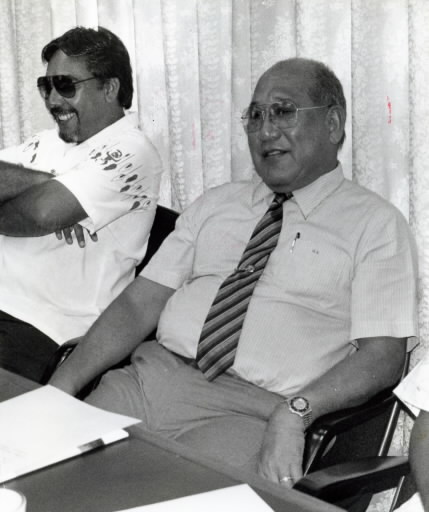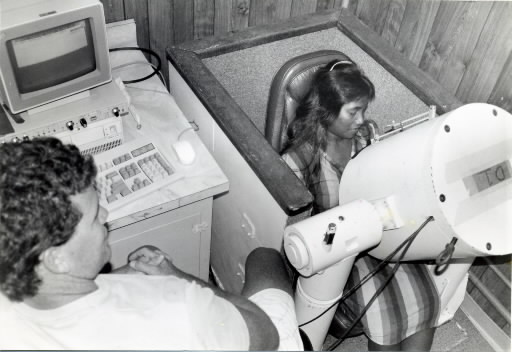4. The Future of Bikini
Feb. 4, 2013
Chapter 3: The Central, South Pacific and Australia
Part 1: The Nuclear Refugees of the Marshall Islands
Part 1: The Nuclear Refugees of the Marshall Islands
A recent issue of the weekly Marshall Islands Journal carried an article entitled "A Brief Glimpse of Their Homeland for the Women of Bikini." It detailed how sixty young women born after the war and presently living on the island of Kili had traveled to Bikini for a look at the homeland they have never known. The women wept as they took their first steps on the land of their forefathers, and later left with memories they would hold precious for the rest of their lives.
Bikini was commandeered by the U.S. government for its nuclear testing program in 1946; the inhabitants were forced off the island with no explanation apart from that they should move for the good of humanity. Almost fifty years have passed since their forced emigration to the isolated island of Kili, more than six hundred miles to the south, but the islanders, who now number over five hundred, have never given up hope of one day returning to their homeland.
In 1973 the growing number of demands to return to Bikini from the former islanders prompted the U.S. government to clean up the remaining contaminated areas. Palm trees were planted and houses built, and finally a small number of islanders were allowed to move back. They discovered, however, that it takes more than replacement of the topsoil to combat the contamination accumulated after twenty-three nuclear explosions. Five years later, those islanders who had returned were found once again to have high levels of radioactive substances in their bodies, and they were sent back to their exile on Kili. The disappointment of these islanders, forced to give up long-cherished dreams of their homeland, and the tears of the young women upon viewing it for the first and possibly only time, are just two more episodes in the tragic history of the displaced people of Bikini Atoll.
The nuclear debate in the Marshall Islands has recently entered a new phase, due to a proposal supported by President Amata Kabua to build a nuclear waste dump. According to the plan, dangerous contaminated materials would be shipped to an island in the northern part of the Rongelap Atoll from nations currently making use of nuclear power generation, such as Japan and the United States. Naturally enough, the former residents of Rongelap, now residing on Mejatto, are protesting vigorously against the plan, so for the time being it has been put on hold. When we visited the president in his prefab White House we could see that he was determined that the construction of the waste dump would go ahead in spite of the residents' protests.
President Kabua, the supreme authority in the Marshall Islands, explained to us the reasoning behind his support for the radioactive waste dump. "The northern part of the Rongelap group is already contaminated. If Japan and America build strong, fail-safe storage facilities, I can see no reason why the people can't return to the southern part of the atoll. The scientists have assured me that it is safe. Besides," he added in Japanese learned during the occupation, "the Marshalls need the money." The facilities the president had in mind were no doubt similar to the concrete dome located on Runit Island in the northern part of the Enewetak Atoll.
Enewetak was used as a nuclear test site in the same way as Bikini; between 1948 and 1958 a total of forty-three bomb tests were carried out. In 1977, in order to return the island to its former inhabitants, all the contaminated material was bulldozed into a large crater formed by the explosions, then covered with a concrete dome. With the encouragement of the U.S. government the exiled islanders have now returned to the southern part of Enewetak. The northern part where the dome is located is strictly off limits. The apparent safety of this arrangement is what has given President Kabua the confidence to make similar plans for Rongelap.
"I've heard the word 'safe' used so many times before, and I refuse to accept the president's proposal." These were the indignant words of Edmil Edmond, one of those we interviewed on Mejatto. Playing the devil's advocate, we suggested that perhaps the plan wasn't such a bad idea, considering that his homeland was already contaminated, and that the islanders could probably make some money out of the proposal.
He was ready with a reply: "If the concrete breaks or the dome is destroyed by a tidal wave, the effects, sure as hell, won't be confined to the Marshall Islands."
When we visited the exiled Rongelap islanders in their new home on Mejatto, a DOE patrol boat, which was used to transport the medical team on its regular visit to Mejatto, was anchored offshore. We went over for a closer look at the vessel.
Three containers on the deck had been converted into rooms for the examination of patients. In the urine analysis room, where the islanders would be checked for the presence of strontium, some boys were watching a video while waiting their turn. In another of the rooms, a middle-aged woman was having the level of radiation in her body measured by a cylindrical device positioned over her stomach.
When we took some photos over the head of the technician, the leader of the team, Dr. Casper Sun of the Brookhaven National Laboratory, called out to us: "We've never found any plutonium or cesium present in the islanders' systems, you know. The only thing that ever shows up is K-40 (potassium), and we all have that in our bodies." In short, the doctor wanted to reassure us that there was nothing to make a fuss about.
When we returned to the island and passed on his words to our interpreter, Nelson Anjain, he did not seem at all surprised.
"They always lie like that," he said, shaking his head. It is hardly surprising that the islanders do not trust the U.S. government. In 1987, they decided to get a second opinion, and called in Canadian and West German specialists to do an independent evaluation of the level of radioactivity on Rongelap. The resulting report, which was completed in April 1988, cast serious doubts on the U.S. assurances of safety.
Using the DOE data as a base, the report concluded that plutonium and americium, supposedly not present in the islanders' bodies, had in fact been detected in small quantities in the urine of some of those tested. Regarding the levels of radiation in the islanders, which the U.S. team had insisted were "safe," it was recommended that everything possible should be done to reduce the amount of radiation, and that any move to return to Rongelap should be given very careful consideration.
Not long before the release of this independent report, the doctors of the DOE medical team had told the residents of Mejatto that the rate of thyroid dysfunction in the Marshalls has already passed its peak. This statement only served to further arouse the suspicion and anger of the islanders, who found it very difficult to take at face value.
During our investigations in the Marshall Islands, we were often asked about the fate of the twenty-three crew members of the Daigo Fukuryu Maru, the Japanese fishing boat caught in radioactive fallout only twenty miles from Rongelap during the Bravo test in 1954. We explained that eight of the crew had since passed away, including one killed in a car accident, and that the remainder were checked every year by doctors of the National Institute of Radiological Sciences, who so far said that they had found no abnormalities. At this, the islanders expressed the opinion that the men were lucky to be receiving what seemed to be proper medical advice. The quiet words of the islander Jabwe Jorju, whom we had met in the capital of Majuro, have stayed with us ever since:
"I heard that in Japan there are a lot of doctors who specialize in treating people affected by the poison. I don't suppose it would be possible to have an examination there, would it?"
Even now, more than thirty-five years after they were forced out of their homes, the victims of nuclear testing in the Marshall Islands are still not provided with medical care that they can trust. Jorju's words echoed the feelings of all the islanders, who despair of ever being told the truth.









